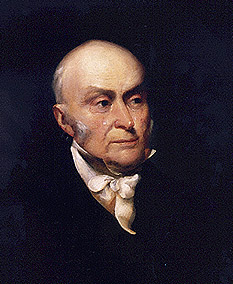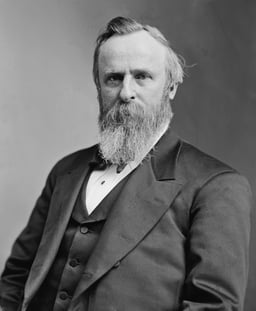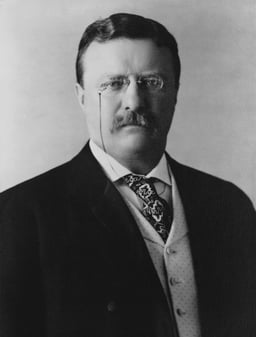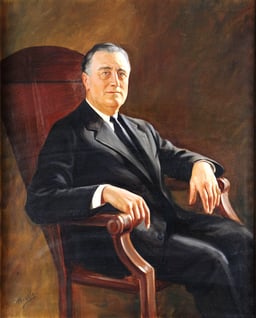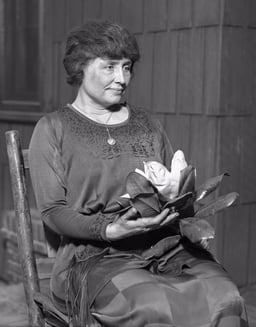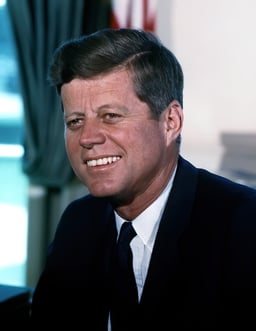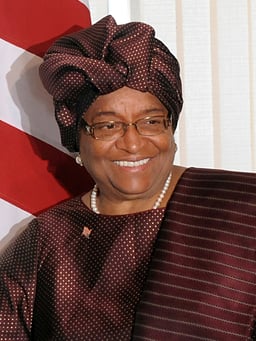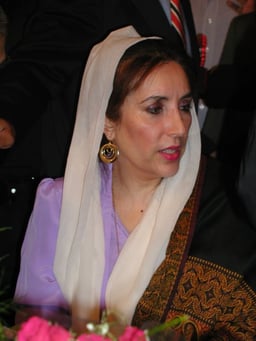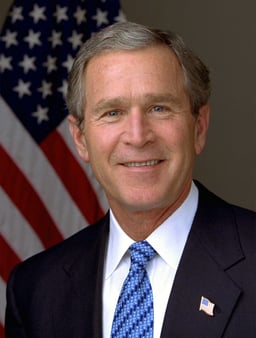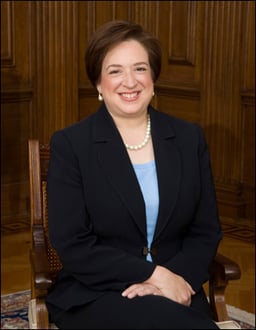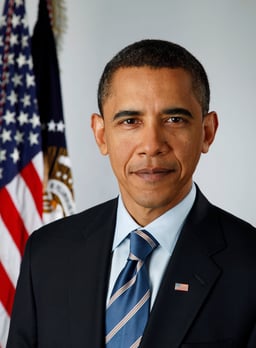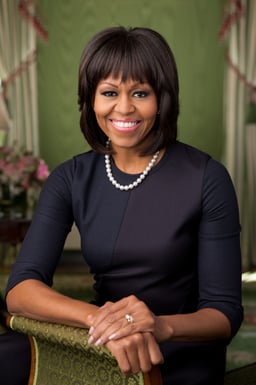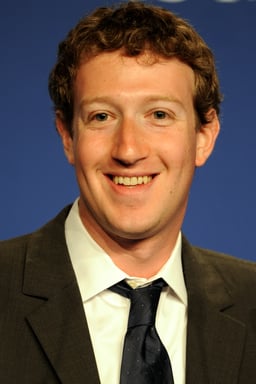Harvard University

Harvard University

| Latin:Universitas Harvardiana | |
| Harvard College | |
| Motto | Veritas[1][2] |
| Truth | |
| Type | Privatenonprofituniversity |
| Established | 1636[3] |
| Endowment | US$38.3 billion (FY 2018)[4][5] |
| President | Lawrence S. Bacow |
| 4,671[6] | |
| Students | 22,000[7] |
| Undergraduates | 6,700[7] |
| Postgraduates | 15,250[7] |
| Location | |
| Campus | Urban210 acres (85 ha) |
| Newspaper | The Harvard Crimson |
| Colors | Crimson][8] |
| Athletics | NCAA Division I–Ivy League |
| Nickname | Harvard Crimson |
| Affiliations | NAICUAICUMAAUURA |
| Website | |
| University rankings | |
| National | |
| ARWU[16] | 1 |
| Forbes[129] | 1 |
| Times/WSJ[130] | 1 |
| U.S. News & World Report[131] | 2 |
| Washington Monthly[132] | 2 |
| Global | |
| ARWU[16] | 1 |
| QS[17] | 3 |
| Times[18] | 7 |
| U.S. News & World Report[19] | 1 |
Harvard University is a private Ivy League research university in Cambridge, Massachusetts, with about 6,700 undergraduate students and about 15,250 postgraduate students. Established in 1636 and named for its first benefactor, clergyman John Harvard, Harvard is the United States' oldest institution of higher learning.[9]*The%20American%20College%20a]]*ts history, influence, wealth, and academic reputation have made it one of the most prestigious universities in the world.[11][12][13][14][15]publishers[16][17][18][19]
The Harvard Corporation, chartered in 1650, is the governing body of Harvard. The early College primarily trained Congregational and Unitarian clergy, although it has never been formally affiliated with any denomination. Its curriculum and student body were gradually secularized during the 18th century, and by the 19th century, Harvard had emerged as the central cultural establishment among Boston elites.[20][21] Following the American Civil War, President Charles W. Eliot's long tenure (1869–1909) transformed the college and affiliated professional schools into a modern research university; Harvard was a founding member of the Association of American Universities in 1900.[22] A. Lawrence Lowell, who followed Eliot, further reformed the undergraduate curriculum and undertook aggressive expansion of Harvard's land holdings and physical plant. James Bryant Conant led the university through the Great Depression and World War II and began to reform the curriculum and liberalize admissions after the war. The undergraduate college became coeducational after its 1977 merger with Radcliffe College.
The university is organized into eleven separate academic units—ten faculties and the Radcliffe Institute for Advanced Study—with campuses throughout the Boston metropolitan area:[23] its 209-acre (85 ha) main campus is centered on Harvard Yard in Cambridge, approximately 3 miles (5 km) northwest of Boston; the business school and athletics facilities, including Harvard Stadium, are located across the Charles River in the Allston neighborhood of Boston; and the medical, dental, and public health schools are in the Longwood Medical Area.[24] Harvard's endowment is worth $39.2 billion, making it the largest of any academic institution.[4] Harvard is a large, highly residential research university.[25] The nominal cost of attendance is high, but the university's large endowment allows it to offer generous financial aid packages.[26] The Harvard Library is the world's largest academic and private library system, comprising 79 individual libraries holding over 18 million items.[27][28][29]
Harvard's alumni include eight U.S. presidents, more than thirty foreign heads of state, 62 living billionaires, 359 Rhodes Scholars, and 242 Marshall Scholars.[30][31][32] As of October 2018, 158 Nobel laureates, 18 Fields Medalists, and 14 Turing Award winners have been affiliated as students, faculty, or researchers.[33] In addition, Harvard students and alumni have won 10 Academy Awards, 48 Pulitzer Prizes and 108 Olympic medals (46 gold, 41 silver and 21 bronze), and have founded many companies worldwide.[34][35][36]
| Latin:Universitas Harvardiana | |
| Harvard College | |
| Motto | Veritas[1][2] |
| Truth | |
| Type | Privatenonprofituniversity |
| Established | 1636[3] |
| Endowment | US$38.3 billion (FY 2018)[4][5] |
| President | Lawrence S. Bacow |
| 4,671[6] | |
| Students | 22,000[7] |
| Undergraduates | 6,700[7] |
| Postgraduates | 15,250[7] |
| Location | |
| Campus | Urban210 acres (85 ha) |
| Newspaper | The Harvard Crimson |
| Colors | Crimson][8] |
| Athletics | NCAA Division I–Ivy League |
| Nickname | Harvard Crimson |
| Affiliations | NAICUAICUMAAUURA |
| Website | |
| University rankings | |
| National | |
| ARWU[16] | 1 |
| Forbes[129] | 1 |
| Times/WSJ[130] | 1 |
| U.S. News & World Report[131] | 2 |
| Washington Monthly[132] | 2 |
| Global | |
| ARWU[16] | 1 |
| QS[17] | 3 |
| Times[18] | 7 |
| U.S. News & World Report[19] | 1 |
History
Colonial

The official seal of the Harvard Corporation. Found on Harvard diplomas, it carries the university's original motto, Christo et Ecclesiae ("For Christ and Church"),[1][2] later changed to Veritas ("Truth").[2]

Engraving of Harvard College by Paul Revere, 1767
Harvard was established in 1636 by vote of the Great and General Court of the Massachusetts Bay Colony. In 1638, it acquired British North America's first known printing press.[37][38] In 1639, it was named Harvard College after deceased clergyman John Harvard, an alumnus of the University of Cambridge, who had left the school £ 779 and his scholar's library of some 400 volumes.[39] The charter creating the Harvard Corporation was granted in 1650.
A 1643 publication gave the school's purpose as "to advance learning and perpetuate it to posterity, dreading to leave an illiterate ministry to the churches when our present ministers shall lie in the dust";[40] in its early years trained many Puritan ministers.[41] It offered a classic curriculum on the English university model—many leaders in the colony had attended the University of Cambridge—but conformed to the tenets of Puritanism. It was never affiliated with any particular denomination, but many of its earliest graduates went on to become clergymen in Congregational and Unitarian churches.[42]
The leading Boston divine Increase Mather served as president from 1685 to 1701. In 1708, John Leverett became the first president who was not also a clergyman, marking a turning of the college from Puritanism and toward intellectual independence.
19th century

John Harvard statue, Harvard Yard
Throughout the 18th century, Enlightenment ideas of the power of reason and free will became widespread among Congregational ministers, putting those ministers and their congregations in tension with more traditionalist, Calvinist parties.[43] When the Hollis Professor of Divinity David Tappan died in 1803 and the president of Harvard Joseph Willard died a year later, in 1804, a struggle broke out over their replacements. Henry Ware was elected to the chair in 1805, and the liberal Samuel Webber was appointed to the presidency of Harvard two years later, which signaled the changing of the tide from the dominance of traditional ideas at Harvard to the dominance of liberal, Arminian ideas (defined by traditionalists as Unitarian ideas).[43] [44]
In 1846, the natural history lectures of Louis Agassiz were acclaimed both in New York and on the campus at Harvard College. Agassiz's approach was distinctly idealist and posited Americans' "participation in the Divine Nature" and the possibility of understanding "intellectual existences". Agassiz's perspective on science combined observation with intuition and the assumption that a person can grasp the "divine plan" in all phenomena. When it came to explaining life-forms, Agassiz resorted to matters of shape based on a presumed archetype for his evidence. This dual view of knowledge was in concert with the teachings of Common Sense Realism derived from Scottish philosophers Thomas Reid and Dugald Stewart, whose works were part of the Harvard curriculum at the time. The popularity of Agassiz's efforts to "soar with Plato" probably also derived from other writings to which Harvard students were exposed, including Platonic treatises by Ralph Cudworth, John Norris and, in a Romantic vein, Samuel Taylor Coleridge. The library records at Harvard reveal that the writings of Plato and his early modern and Romantic followers were almost as regularly read during the 19th century as those of the "official philosophy" of the more empirical and more deistic Scottish school.[45]
Charles W. Eliot, president 1869–1909, eliminated the favored position of Christianity from the curriculum while opening it to student self-direction. While Eliot was the most crucial figure in the secularization of American higher education, he was motivated not by a desire to secularize education, but by Transcendentalist Unitarian convictions. Derived from William Ellery Channing and Ralph Waldo Emerson, these convictions were focused on the dignity and worth of human nature, the right and ability of each person to perceive truth, and the indwelling God in each person.[46]
20th century
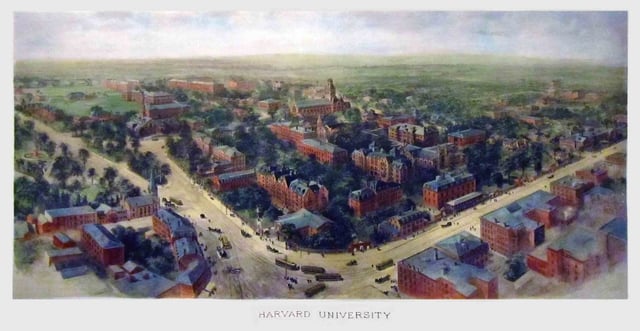
Richard Rummell's 1906 watercolor landscape view, facing northeast.[47]
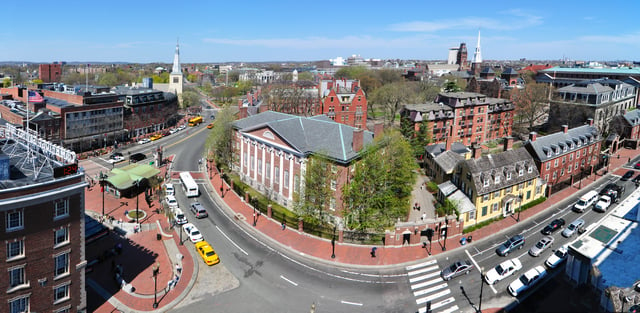
Harvard Yard as seen from the Smith Campus Center
During the 20th century, Harvard's international reputation grew as a burgeoning endowment and prominent professors expanded the university's scope.
Rapid enrollment growth continued as new graduate schools were begun and the undergraduate College expanded.
Radcliffe College, established in 1879 as sister school of Harvard College, became one of the most prominent schools for women in the United States. Harvard became a founding member of the Association of American Universities in 1900.[22]
In the early 20th century, the student body was predominantly "old-stock, high-status Protestants, especially Episcopalians, Congregationalists, and Presbyterians"—a group later called "WASPs" (White Anglo-Saxon Protestants). In 1923 a proposal by president A. Lawrence Lowell that Jews be limited to 15% of undergraduates was rejected, but Lowell did ban blacks from living in Harvard Yard; Lowell believed that "forcing" blacks and whites to live together "would increase a prejudice that... is most unfortunate and probably growing." But by the 1970s, Harvard was much more diversified.[48][49][50][51]
James Bryant Conant (president, 1933–1953) reinvigorated creative scholarship to guarantee its preeminence among research institutions. He saw higher education as a vehicle of opportunity for the talented rather than an entitlement for the wealthy, so Conant devised programs to identify, recruit, and support talented youth. In 1943, he asked the faculty make a definitive statement about what general education ought to be, at the secondary as well as the college level. The resulting Report, published in 1945, was one of the most influential manifestos in the history of American education in the 20th century.[52]
In 1945–1960 admissions policies were opened up to bring in students from a more diverse applicant pool.
No longer drawing mostly from rich alumni of select New England prep schools, the undergraduate college was now open to striving middle class students from public schools; many more Jews and Catholics were admitted, but few blacks, Hispanics or Asians.[53]
Harvard graduate schools began admitting women in small numbers in the late 19th century, and during World War II, students at Radcliffe College (which since 1879 had been paying Harvard professors to repeat their lectures for women students) began attending Harvard classes alongside men,[54] The first class of women was admitted to Harvard Medical School in 1945.[55] Since the 1970s Harvard has been responsible for essentially all aspects of admission, instruction, and undergraduate life for women, and Radcliffe was formally merged into Harvard in 1999.[56]
21st century
Campuses
Cambridge

University seal
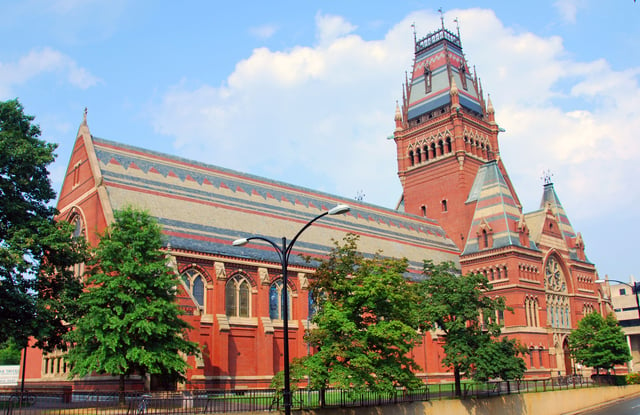
Memorial Hall

Memorial Church
Harvard's 209-acre (85 ha) main campus is centered on Harvard Yard in Cambridge, about 3 miles (5 km) west-northwest of downtown Boston, and extends into the surrounding Harvard Square neighborhood. Harvard Yard itself contains the central administrative offices and main libraries of the university, academic buildings including Sever Hall and University Hall, Memorial Church, and the majority of the freshman dormitories. Sophomore, junior, and senior undergraduates live in twelve residential Houses, nine of which are south of Harvard Yard along or near the Charles River. The other three are located in a residential neighborhood half a mile northwest of the Yard at the Quadrangle (commonly referred to as the Quad), which formerly housed Radcliffe College students until Radcliffe merged its residential system with Harvard. Each residential house contains rooms for undergraduates, House masters, and resident tutors, as well as a dining hall and library. The facilities were made possible by a gift from Yale University alumnus Edward Harkness.[60]
Radcliffe Yard, formerly the center of the campus of Radcliffe College and now home of the Radcliffe Institute for Advanced Study at Harvard,[61] is adjacent to the Graduate School of Education and the Cambridge Common.
Between 2014 and 2016, Harvard University reported crime statistics for its main Cambridge campus that included 141 forcible sex offenses, 33 robberies, 46 aggravated assaults, 151 burglaries, and 32 cases of motor vehicle theft.[62]
Allston
The Harvard Business School and many of the university's athletics facilities, including Harvard Stadium, are located on a 358-acre (145 ha) campus in Allston,[65] a Boston neighborhood across the Charles River from the Cambridge campus. The John W. Weeks Bridge, a pedestrian bridge over the Charles River, connects the two campuses. Intending a major expansion, Harvard now owns more land in Allston than it does in Cambridge.[66] A ten-year plan[67] calls for 1.4 million square feet (130,000 square meters) of new construction and 500,000 square feet (50,000 square meters) of renovations, including new and renovated buildings at Harvard Business School; a hotel and conference center; a multipurpose institutional building; renovations to graduate student housing and to Harvard Stadium; new athletic facilities; new laboratories and classrooms for the John A. Paulson School of Engineering and Applied Sciences; expansion of the Harvard Education Portal; and a district energy facility.
Longwood
Further south, the Harvard Medical School, Harvard School of Dental Medicine, and the Harvard School of Public Health are located on a 21-acre (8.5 ha) campus in the Longwood Medical and Academic Area about 3.3 miles (5.3 km) south of the Cambridge campus, and the same distance southwest of downtown Boston.[24] The Arnold Arboretum, in the Jamaica Plain neighborhood of Boston, is also owned and operated by Harvard.
Other
Harvard also owns and operates the Dumbarton Oaks Research Library and Collection, in Washington, D.C.; the Harvard Forest in Petersham, Massachusetts; the Concord Field Station in Estabrook Woods in Concord, Massachusetts[68] and the Villa I Tatti research center[69] in Florence, Italy. Harvard also operates the Harvard Shanghai Center in China.[70]
Organization and administration
Governance

Harvard Medical School
| College/school | Year founded |
| Harvard College | 1636 |
| Medicine | 1782 |
| Divinity | 1816 |
| Law | 1817 |
| Dental Medicine | 1867 |
| Arts and Sciences | 1872 |
| Business | 1908 |
| Extension | 1910 |
| Design | 1914 |
| Education | 1920 |
| Public Health | 1922 |
| Government | 1936 |
| Engineering and Applied Sciences | 2007 |
Harvard is governed by a combination of its Board of Overseers and the President and Fellows of Harvard College (also known as the Harvard Corporation), which in turn appoints the President of Harvard University.[71] There are 16,000 staff and faculty,[72] including 2,400 professors, lecturers, and instructors[73] teaching 7,200 undergraduates and 14,000 graduate students.[74]
The Faculty of Arts and Sciences has primary responsibility for instruction in Harvard College, Graduate School of Arts and Sciences, and the Harvard Division of Continuing Education, which includes Harvard Summer School and Harvard Extension School. There are ten other graduate and professional school faculties, in addition to the Radcliffe Institute for Advanced Study.
Joint programs with the Massachusetts Institute of Technology include the Harvard-MIT Division of Health Sciences and Technology, the Broad Institute, The Observatory of Economic Complexity, and edX.
Endowment
Harvard has the largest university endowment in the world. In terms of endowment per student, it ranks third in the U.S., after Princeton and Yale. As of September 2011, it had nearly regained the loss suffered during the 2008 recession. It was worth $32 billion in 2011, up from $28 billion in September 2010[75] and $26 billion in 2009. It suffered about 30% loss in 2008–2009.[76][77] In December 2008, Harvard announced that its endowment had lost 22% (approximately $8 billion) from July to October 2008, necessitating budget cuts.[78] Later reports suggest the loss was actually more than double that figure, a reduction of nearly 50% of its endowment in the first four months alone. Forbes in March 2009 estimated the loss to be in the range of $12 billion.[80] One of the most visible results of Harvard's attempt to re-balance its budget was their halting of construction of the $1.2 billion Allston Science Complex that had been scheduled to be completed by 2011, resulting in protests from local residents.[81] As of 2012, Harvard University had a total financial aid reserve of $159 million for students, and a Pell Grant reserve of $4.093 million available for disbursement.[82]
Divestment
Since the 1970s, several campaigns have sought to divest Harvard's endowment from holdings the campaigns opposed, including investments in apartheid South Africa, the tobacco industry, Sudan during the Darfur genocide, and the fossil fuel industry.[83]
During the divestment from South Africa movement in the late 1980s, student activists erected a symbolic "shantytown" on Harvard Yard and blockaded a speech given by South African Vice Consul Duke Kent-Brown.[84][85] The Harvard Management Company repeatedly refused to divest, stating that "operating expenses must not be subject to financially unrealistic strictures or carping by the unsophisticated or by special interest groups."[86] However, the university did eventually reduce its South African holdings by $230 million (out of $400 million) in response to the pressure.[84][87]
Academics
Admission
Undergraduate admission to Harvard is characterized by the Carnegie Foundation as "more selective, lower transfer-in".[25] Harvard College accepted 5.2% of applicants for the class of 2021, a record low and the second lowest acceptance rate among all national universities.[88][89] Harvard College ended its early admissions program in 2007 as the program was believed to disadvantage low-income and under-represented minority applicants applying to selective universities, but for the class of 2016, an early action program was reintroduced.[90]
The freshman class that entered in the fall of 2017 was the first to be predominantly (50.8%) nonwhite.[91]
Harvard's undergraduate admission policies on preference for children of alumni has been criticized as favoring white, wealthy candidates.[92][93] Admission is based on academic prowess, extracurricular activities and "personality" (judged subjectively by admissions officers who have not met the applicants), and it is alleged that this approach discriminates against Asians.[94][95][96]
Teaching and learning
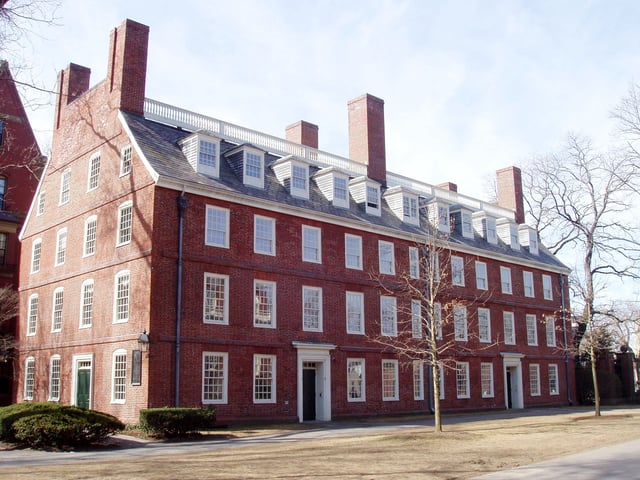
Massachusetts Hall (1720), Harvard's oldest building[97]
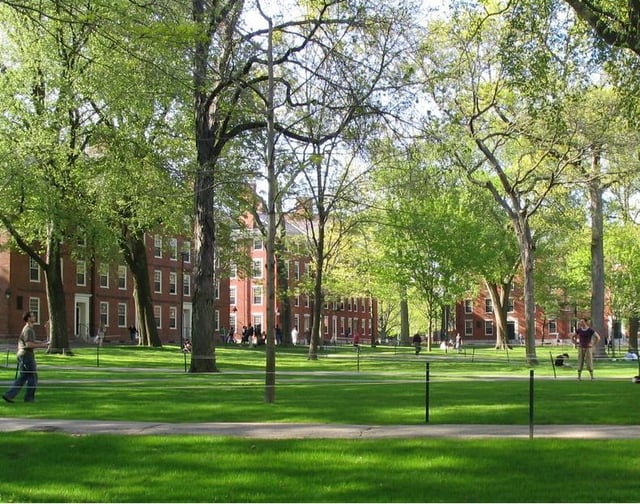
Harvard Yard
Harvard is a large, highly residential research university.[25] The university has been accredited by the New England Association of Schools and Colleges since 1929.[98] The university offers 46 undergraduate concentrations (majors),[99] 134 graduate degrees,[100] and 32 professional degrees.[101] For the 2008–2009 academic year, Harvard granted 1,664 baccalaureate degrees, 400 master's degrees, 512 doctoral degrees, and 4,460 professional degrees.[101]
The four-year, full-time undergraduate program comprises a minority of enrollments at the university and emphasizes instruction with an "arts and sciences focus".[25] Between 1978 and 2008, entering students were required to complete a core curriculum of seven classes outside of their concentration.[102] Since 2008, undergraduate students have been required to complete courses in eight General Education categories: Aesthetic and Interpretive Understanding, Culture and Belief, Empirical and Mathematical Reasoning, Ethical Reasoning, Science of Living Systems, Science of the Physical Universe, Societies of the World, and United States in the World.[103] Harvard offers a comprehensive doctoral graduate program, and undergraduate degrees.[25] The Carnegie Foundation for the Advancement of Teaching, The New York Times, and some students have criticized Harvard for its reliance on teaching fellows for some aspects of undergraduate education; they consider this to adversely affect the quality of education.[104][105]
Harvard's academic programs operate on a semester calendar beginning in early September and ending in mid-May.[106] Undergraduates typically take four half-courses per term and must maintain a four-course rate average to be considered full-time.[107] In many concentrations, students can elect to pursue a basic program or an honors-eligible program requiring a senior thesis and/or advanced course work.[108] Students graduating in the top 4–5% of the class are awarded degrees summa cum laude, students in the next 15% of the class are awarded magna cum laude, and the next 30% of the class are awarded cum laude.[109] Harvard has chapters of academic honor societies such as Phi Beta Kappa and various committees and departments also award several hundred named prizes annually.[110] Harvard, along with other universities, has been accused of grade inflation,[111] although there is evidence that the quality of the student body and its motivation have also increased.[112] Harvard College reduced the number of students who receive Latin honors from 90% in 2004 to 60% in 2005. Moreover, the honors of "John Harvard Scholar" and "Harvard College Scholar" would now be given only to the top 5 percent and the next 5 percent of each class.[113][114][115][116]
University policy is to expel students engaging in academic dishonesty to discourage a "culture of cheating."[117][118][119] In 2012, dozens of students were expelled for cheating after an investigation of more than 120 students.[120] In 2013, there was a report that as many as 42% of incoming freshmen had cheated on homework prior to entering the university,[121] and these incidents have prompted the university to consider adopting an honor code.[119][122]
For the 2012–2013 school year, annual tuition was $38,000, with a total cost of attendance of $57,000.[123] Beginning in 2007, families with incomes below $60,000 pay nothing for their children to attend, including room and board.
Families with incomes between $60,000 to $80,000 pay only a few thousand dollars per year, and families earning between $120,000 and $180,000 pay no more than 10% of their annual incomes.[26] In 2009, Harvard offered grants totaling $414 million; $340 million came from institutional funds, $35 million from federal support, and $39 million from other outside support.
Grants total 88% of Harvard's aid for undergraduate students, with aid also provided by loans (8%) and work-study (4%).[124] Tuition only covers 6.4% of Harvard's operating costs.[125]
Research
Harvard is a founding member of the Association of American Universities[126] and remains a research university with "very high" research activity and a "comprehensive" doctoral program across the arts, sciences, engineering, and medicine.[25] Research and development expenditures in 2011 totaled $650 million, 27th among American universities.[127]
Libraries and museums
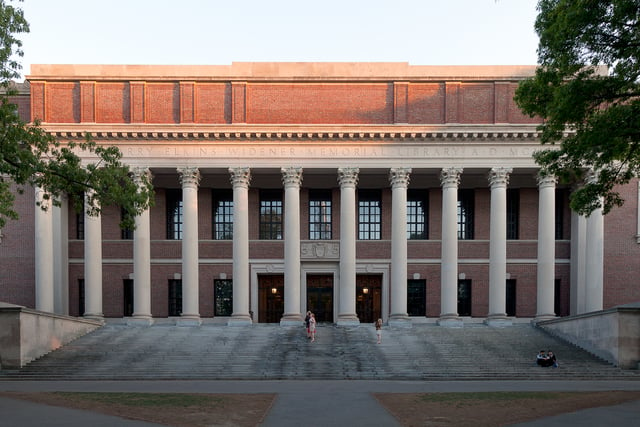
Widener Library anchors the Harvard University Library system.

Henry Moore's sculpture Large Four Piece Reclining Figure, near Lamont Library
The Harvard University Library system is centered in Widener Library in Harvard Yard and comprises nearly 80 individual libraries holding over 18 million volumes.[27][28] According to the American Library Association, this makes it the largest academic library in the United States, and one of the largest in the world.[28]
Houghton Library, the Arthur and Elizabeth Schlesinger Library on the History of Women in America, and the Harvard University Archives consist principally of rare and unique materials.
America's oldest collection of maps, gazetteers, and atlases both old and new is stored in Pusey Library and open to the public.
The largest collection of East-Asian language material outside of East Asia is held in the Harvard-Yenching Library.
The Harvard Art Museums comprise three museums. The Arthur M. Sackler Museum includes collections of ancient, Asian, Islamic and later Indian art, the Busch-Reisinger Museum, formerly the Germanic Museum, covers central and northern European art, and the Fogg Museum of Art, covers Western art from the Middle Ages to the present emphasizing Italian early Renaissance, British pre-Raphaelite, and 19th-century French art. The Harvard Museum of Natural History includes the Harvard Mineralogical Museum, Harvard University Herbaria featuring the Blaschka Glass Flowers exhibit, and the Museum of Comparative Zoology. Other museums include the Carpenter Center for the Visual Arts, designed by Le Corbusier, housing the film archive, the Peabody Museum of Archaeology and Ethnology, specializing in the cultural history and civilizations of the Western Hemisphere, and the Semitic Museum featuring artifacts from excavations in the Middle East.
Rankings
| National Program Rankings[133] | |||
|---|---|---|---|
| Program | Ranking | ||
| Biological Sciences | 4 | ||
| Business | 3 | ||
| Chemistry | 2 | ||
| Clinical Psychology | 16 | ||
| Computer Science | 16 | ||
| Earth Sciences | 8 | ||
| Economics | 1 | ||
| Education | 1 | ||
| Engineering | 21 | ||
| English | 8 | ||
| History | 4 | ||
| Law | 3 | ||
| Mathematics | 2 | ||
| Medicine: Primary Care | 17 | ||
| Medicine: Research | 1 | ||
| Physics | 3 | ||
| Political Science | 1 | ||
| Psychology | 3 | ||
| Public Affairs | 3 | ||
| Public Health | 2 | ||
| Sociology | 1 | ||
| Statistics | 3 | ||
| Global Program Rankings[134] | |||
|---|---|---|---|
| Program | Ranking | ||
| Agricultural Sciences | 26 | ||
| Arts & Humanities | 2 | ||
| Biology & Biochemistry | 1 | ||
| Chemistry | 9 | ||
| Clinical Medicine | 1 | ||
| Computer Science | 35 | ||
| Economics & Business | 1 | ||
| Engineering | 36 | ||
| Environment/Ecology | 3 | ||
| Geosciences | 7 | ||
| Immunology | 1 | ||
| Materials Science | 5 | ||
| Mathematics | 11 | ||
| Microbiology | 1 | ||
| Molecular Biology & Genetics | 1 | ||
| Neuroscience & Behavior | 1 | ||
| Pharmacology & Toxicology | 1 | ||
| Physics | 4 | ||
| Plant & Animal Science | 18 | ||
| Psychiatry/Psychology | 1 | ||
| Social Sciences & Public Health | 1 | ||
| Space Science | 2 | ||
Among overall rankings, the Academic Ranking of World Universities (ARWU) has ranked Harvard as the world's best university every year since it was first released.[135] When QS and Times Higher Education (THE) were published in partnership as the THE-QS World University Rankings during 2004–2009, Harvard had held the top spot every year, so has it on THE World Reputation Rankings ever since it was released in 2011.[136] In 2019, it ranked 1st among universities around the world by SCImago Institutions Rankings.[137]
Regarding rankings of specific indicators, Harvard topped both University Ranking by Academic Performance 2015–2016 and Mines ParisTech: Professional Ranking of World Universities (2011), which measured universities' numbers of alumni holding CEO positions in Fortune Global 500 companies.[138] According to the 2016 poll done by The Princeton Review, Harvard is the second most commonly named "dream college" in the United States, both for students and parents.[139] College ROI Report: Best Value Colleges by PayScale puts Harvard 22nd nationwide in the most recent 2016 edition.[140]
Student life
| Undergrad | Graduate | U.S. census | |
|---|---|---|---|
| Asian/Pacific Islander | 17% | 11% | 5% |
| Black/non-Hispanic | 6% | 4% | 12% |
| Hispanics of any race | 9% | 5% | 16% |
| White/non-Hispanic | 46% | 43% | 64% |
| Mixed race/other | 10% | 8% | 9% |
| International students | 11% | 27% | N/A |
Student body
In the last six years, Harvard's student population ranged from 19,000 to 21,000, across all programs.[73] Harvard enrolled 6,655 students in undergraduate programs, and over 14,000 students in graduate and professional programs.[141] The undergraduate population is 51% female, while the graduate population is 48% female.[141]
The Harvard Undergraduate Council and Harvard Graduate Council are the chief organs of student government.
Athletics
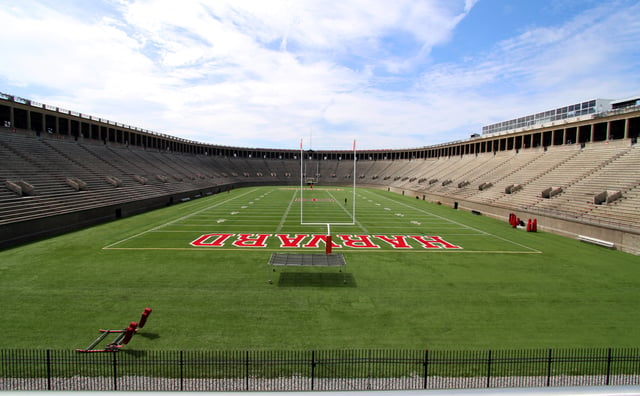
Harvard Stadium, home of Harvard Crimson and the Boston Cannons
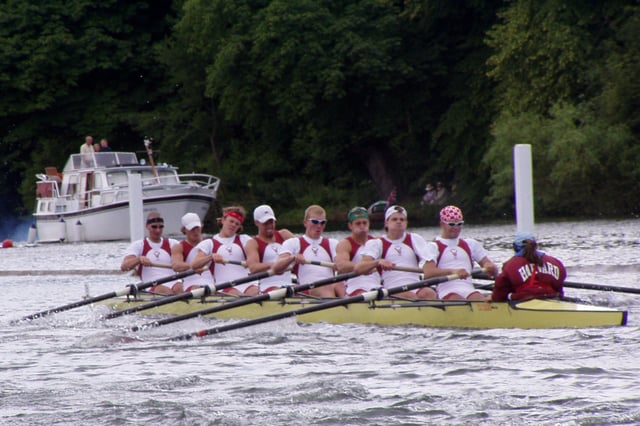
Harvard men's eight crew at Henley, 2004
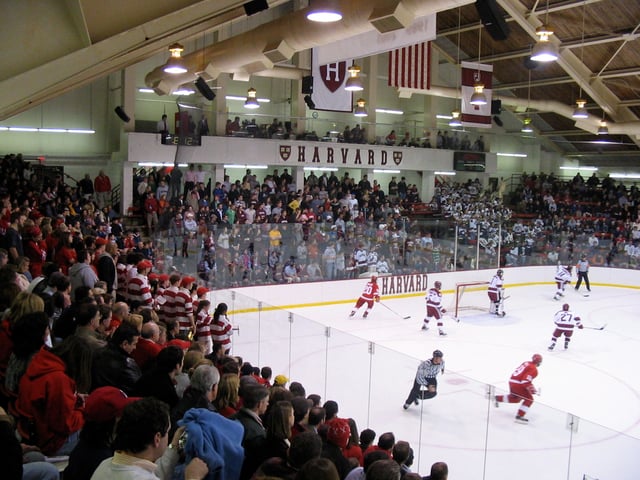
The Cornell–Harvard hockey rivalry match, 2006
The Harvard Crimson competes in 42 intercollegiate sports in the NCAA Division I Ivy League. Harvard has an intense athletic rivalry with Yale University culminating in The Game, although the Harvard–Yale Regatta predates the football game. This rivalry is put aside every two years when the Harvard and Yale Track and Field teams come together to compete against a combined Oxford University and Cambridge University team, a competition that is the oldest continuous international amateur competition in the world.[145]
Harvard's athletic rivalry with Yale is intense in every sport in which they meet, coming to a climax each fall in the annual football meeting, which dates back to 1875 and is usually called simply "The Game". While Harvard's football team is no longer one of the country's best as it often was a century ago during football's early days (it won the Rose Bowl in 1920), both it and Yale have influenced the way the game is played. In 1903, Harvard Stadium introduced a new era into football with the first-ever permanent reinforced concrete stadium of its kind in the country. The stadium's structure actually played a role in the evolution of the college game. Seeking to reduce the alarming number of deaths and serious injuries in the sport, Walter Camp (former captain of the Yale football team), suggested widening the field to open up the game. But the stadium was too narrow to accommodate a wider playing surface. So, other steps had to be taken. Camp would instead support revolutionary new rules for the 1906 season. These included legalizing the forward pass, perhaps the most significant rule change in the sport's history.[146][147]
Harvard has several athletic facilities, such as the Lavietes Pavilion, a multi-purpose arena and home to the Harvard basketball teams. The Malkin Athletic Center, known as the "MAC", serves both as the university's primary recreation facility and as a satellite location for several varsity sports. The five-story building includes two cardio rooms, an Olympic-size swimming pool, a smaller pool for aquaerobics and other activities, a mezzanine, where all types of classes are held, an indoor cycling studio, three weight rooms, and a three-court gym floor to play basketball. The MAC offers personal trainers and specialty classes. It is home to Harvard volleyball, fencing and wrestling.
Weld Boathouse and Newell Boathouse house the women's and men's rowing teams, respectively. The men's crew also uses the Red Top complex in Ledyard, Connecticut, as their training camp for the annual Harvard–Yale Regatta. The Bright Hockey Center hosts the Harvard hockey teams, and the Murr Center serves both as a home for Harvard's squash and tennis teams as well as a strength and conditioning center for all athletic sports.
Older than The Game by 23 years, the Harvard–Yale Regatta was the original source of the athletic rivalry between the two schools. It is held annually in June on the Thames River in eastern Connecticut. The Harvard crew is typically considered to be one of the top teams in the country in rowing. Today, Harvard fields top teams in several other sports, such as the Harvard Crimson men's ice hockey team (with a strong rivalry against Cornell), squash, and even recently won NCAA titles in Men's and Women's Fencing. Harvard also won the Intercollegiate Sailing Association National Championships in 2003.
Harvard's men's ice hockey team won the school's first NCAA Championship in any team sport in 1989.
Harvard was also the first Ivy League institution to win an NCAA championship title in a women's sport when its women's lacrosse team won the NCAA Championship in 1990.
Harvard Undergraduate Television
The school color is crimson, which is also the name of the Harvard sports teams and the daily newspaper, The Harvard Crimson. The color was unofficially adopted (in preference to magenta) by an 1875 vote of the student body, although the association with some form of red can be traced back to 1858, when Charles William Eliot, a young graduate student who would later become Harvard's 21st and longest-serving president (1869–1909), bought red bandanas for his crew so they could more easily be distinguished by spectators at a regatta.
Fight songs
Harvard has several fight songs, the most played of which, especially at football, are "Ten Thousand Men of Harvard" and "Harvardiana." While "Fair Harvard" is actually the alma mater, "Ten Thousand Men" is better known outside the university. The Harvard University Band performs these fight songs, and other cheers at football and hockey games. These were parodied by Harvard alumnus Tom Lehrer in his song "Fight Fiercely, Harvard," which he composed while an undergraduate.
Notable people
Alumni
Faculty
Harvard's faculty includes scholars such as biologist E. O. Wilson, psychologist Steven Pinker, physicists Lisa Randall and Roy Glauber, chemists Elias Corey, Dudley R. Herschbach and George M. Whitesides, computer scientists Michael O. Rabin and Leslie Valiant, Shakespeare scholar Stephen Greenblatt, writer Louis Menand, critic Helen Vendler, historians Henry Louis Gates, Jr. and Niall Ferguson, economists Amartya Sen, N. Gregory Mankiw, Robert Barro, Stephen A. Marglin, Don M. Wilson III and Martin Feldstein, political philosophers Harvey Mansfield, Baroness Shirley Williams and Michael Sandel, Fields Medalist mathematician Shing-Tung Yau, political scientists Robert Putnam, Joseph Nye, and Stanley Hoffmann, scholar/composers Robert Levin and Bernard Rands, astrophysicist Alyssa A. Goodman, and legal scholars Alan Dershowitz and Lawrence Lessig.
Past faculty members include Stephen Jay Gould, Robert Nozick, Stephan Thernstrom, Sanford J. Ungar, Michael Walzer, and Cornel West.
Literature and popular culture

Tower at the University of Puerto Rico, showing (right) the emblem of Harvard University—the oldest in the United States—and * (left)* that of National University of San Marcos, Lima—the oldest in the Americas
The perception of Harvard as a center of either elite achievement, or elitist privilege, has made it a frequent literary and cinematic backdrop.
"In the grammar of film, Harvard has come to mean both tradition, and a certain amount of stuffiness," film critic Paul Sherman has said.[150]
Literature
William Faulkner's The Sound and the Fury (1929) and Absalom! Absalom!
Of Time and the River (1935), Thomas Wolfe's fictionalized autobiography, includes his alter ego's student days at Harvard.
The Late George Apley (1937; winner of the Pulitzer Prize), by John P. Marquand, parodies Harvard men at the opening of the 20th century.
The Second Happiest Day (1953), by John P. Marquand, Jr., depicts the Harvard of the World War II generation.[151][152][153][154][155]
The Accidental Billionaires (2009), by Ben Mezrich.
Film
Erich Segal's Love Story (1970), which concerns a romance between a wealthy hockey player (Ryan O'Neal) and a brilliant Radcliffe student of modest means (Ali MacGraw), is screened annually for incoming freshmen.[158][159][160]
The Paper Chase (1973)[161]
With Honors (1994)[162]
Good Will Hunting (1997), written by Matt Damon as a student in a playwriting class
Prozac Nation
Legally Blonde
Stealing Harvard
Angels & Demons
The Social Network
See also
2012 Harvard cheating scandal
Academic regalia of Harvard University
Colonial colleges
Gore Hall
Harvard University Police Department
Harvard University Press
Harvard/MIT Cooperative Society
I, Too, Am Harvard
List of oldest universities in continuous operation
List of universities by number of billionaire alumni
Officially unrecognized Harvard College social clubs
Outline of Harvard University
President of Harvard University
Secret Court of 1920
Harvard-MIT Division of Health Sciences and Technology
The Observatory of Economic Complexity
edX
Broad Institute

